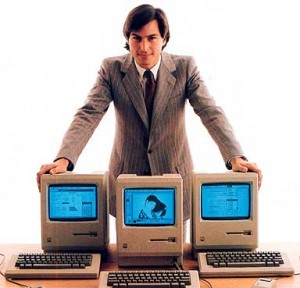There is no doubt that Steve Jobs was an incredible guy who has left a lasting legacy. He was also pretty crazy a lot of the time. Jobs experimented with LSD, followed weird diets, ignored medical advice, and pretty much did what he wanted most of the time. There are a number of reasons he was so successful but the couple of things that stood out for me were his "make it happen" attitude and his insistence on quality, even if it appears he took these to an irrational excess at times.
After reading the bio, I've discovered a strange appreciation for Apple products. Their simplicity and user-friendliness, which drive a lot of the Apple innovation, is very attractive. You may have noticed that many companies are now embracing a Zen-ish simplicity, e.g. Google's recent changes to Gmail, Blogger, Reader, etc... Whether this is directly due to Jobs and Apple or not I can't tell for sure, but the bio does record Larry Page visiting Jobs at his house.
One other aspect of Apple design that deserves a mention is the focus on completely integrated design. There are no bolt on parts to make up the whole, instead products are considered as a whole with features of every part reliant on every other part in their design and function. This leads to great gains in efficiency but lead to much higher production costs and therefore retail costs.
So, after receiving all of this inside information and insight into Apple, I can say that I really do appreciate their products. Unfortunately there is a downside, and it's not the cost. My sort of creativity and innovation doesn't work too well with Apple products. Sure, for writing, drawing, snapping pictures, video, etc. I could use an Apple device, but once I have that media I can't seem to bend the Apple device to do my bidding. I am convinced that this is due to their insistence on having only Apple software, to preserve the Apple experience, and also due to their overly strict digital rights management. Copyright ruins Apple for me.
So proud of their intuitive interface, Apple loses this intuitive interaction with the user when they disable naturally intuitive features like sharing. Also, with iTunes, it is awkward to get your media into a commonly used format and in New Zealand your options for media to purchase on iTunes are vastly diminished. Even their payment system, using gift cards to top up your account balance rather than using it like every other gift voucher (at the checkout), fails the intuition test. The small print on the card? Who reads small print these days? The prices through iTunes are still way out also. Why buy a digital copy of a movie for $25 when that is more expensive than a DVD?
What I inevitably find with Apple products is that I love the device and the hardware interface, but the software just doesn't allow me to be innovative and creative the way that something more open (like Android) does. So after years of trying to have a good experience with Apple products, I have finally given up. I'm not going to experiment with an iPad because it costs too much and I'm almost certain I won't like it - what a waste of money. Instead I plan to wait until decent Android tablets become cheaper (and they will because that's what happened with smart-phones).
Now, I'm a realist. I know that my issues with Apple may change or become irrelevant. I know these issues are not entirely an Apple issue (blame is due to the big music and movie corps too). I also recognise the quality of the hardware, and the suitability of Apple products for digital immigrants and others seeking a simpler technological interaction experience. So if you, or anyone you know wants to give me a free iPad (you never know...) I will still give it a go in the interest of fairness.
I know that people get pretty passionate about their Apple devices, so feel free to rant at me in the comments below. I'm half expecting some Apple cult members to show up and defend their faith, but they should remember that we'd only be arguing about different values - I value a different type of creativity in addition to theirs, and I'm not willing to surrender that.
I'll leave you with a video clip of Steve Jobs launching the iPad 2. Despite the effects of terminal illness on his body, you can see the magic. Enjoy:

